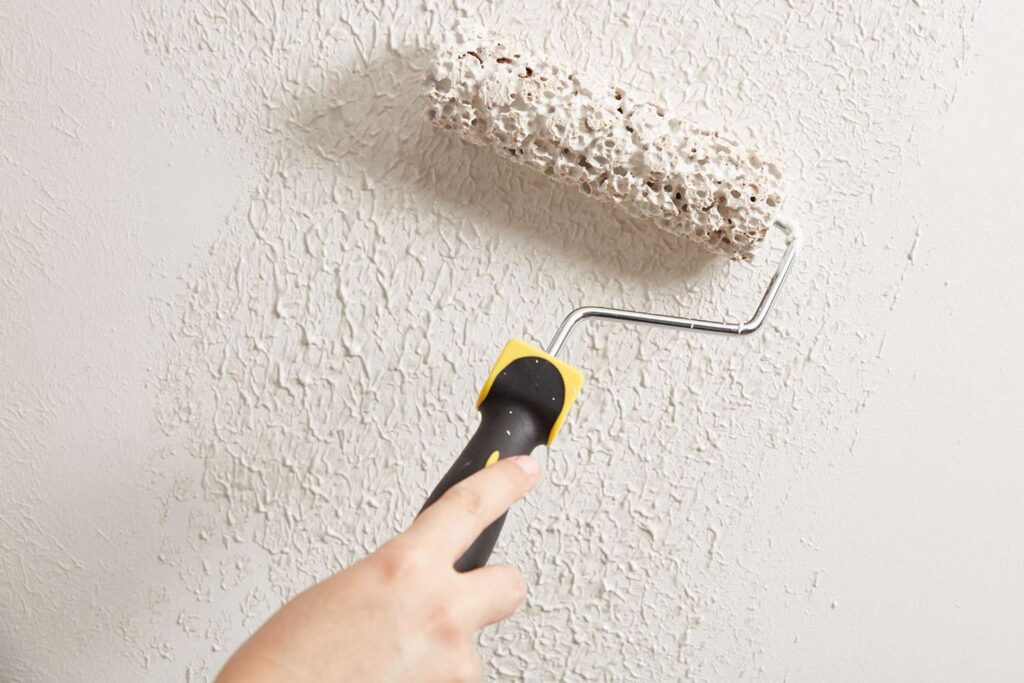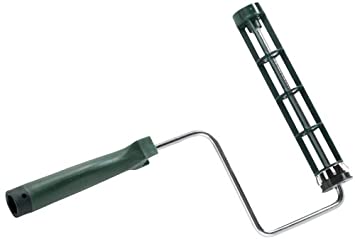Are you thinking about turning that textured wall in the lounge into a focal point? Painting a textured wall requires the best paint roller for textured walls and the right approach to painting the surface.
This brief guide gives you everything you need to know about selecting the best paint roller for textured walls.
The best paint roller for interior walls
Wooster R017-9 Roller Frame, 9-Inch, Silver
If you’re looking to paint textured interior walls, this paint roller from Wooster is your best choice. This model features a design from one of the leading DIY painting brands on the market. Wooster produces some of the best painting materials and tools for any job.
This Wooster roller is a 9-inch model, making it the perfect versatile roller for painting any size wall in the home. The 9-inch length gives you decent coverage while enhancing the control you have over the roller in corners and tighter spots.
The 9-inch Sherlock frame comes with a chrome-plated 5/16” shank, mounted at a 90˚ angle. You get corrosion resistance and plenty of strength to resist pressure placed on the roller during painting.
Tip: use the best paint for trim!
The result is a smooth rolling action, even with the heaviest paint loads and nap lengths. The rolling Acton of the bearings reduces the wear on the shank and grey streaks when painting.
The roller also features a quick-release retaining spring, preventing roller slippage in use. The innovative design of the roller head also allows for easy, one-cap removal and stripping of the roller cover.
The Wooster 9-ich roller frame also includes an ergonomic, full-size polypropylene grip. The length of the grip makes it easy for the painter to control the roller at any angle and when working overhead. The ergonomic design helps to reduce fatigue in the wrists, letting you finish the job faster.
The handle also comes with reinforced threads, and it’s Sherlock GT compatible, allowing you to add extension arms for painting high walls or ceilings in or around the home.
Overall, the Wooster 9-inch roller frame is the ideal roller for your interior paint job. It offers top-quality performance, with user-friendly operation, at an affordable price.
The best paint roller cover for interior walls
Wooster Brush R291-9 Lambswool 100 Roller
After selecting the best paint roller for your textured interior walls, it’s time to settle on the right roller cover for the task.
The Wooster lambswool 100 roller cover is our top companion choice for the Wooster 9-inch paint roller. Not only do Wooster design and build some of the best paint rollers, but they have a range of outstanding roller covers suitable for any painting task.
This R291-9 lambswool 100 roller cover is a top choice for painting interior textured walls around the home. This model comes with a 100% lambswool material, a knitted finish, and a 9″ to 0.5″ pile. It’s suitable for medium-textured surfaces, offering you excellent coverage and enough nap to fill crevices and gaps in the textured surface.
The lambswool in the cover comes knitted to a synthetic backing, ensuring the longest service life possible from this cover. This cover works well with all paint types, including latex paints. It’s the ideal choice for use with flat or satin-finish paints, giving you plenty of coverage and fewer stops to the paint tray to reload the roller.
The green double-thick polypropylene roller core prevents cracking and damage from water solvents, ensuring the roller cover retains its shape.
Finding the best paint roller holder for the Job
How to buy the best paint roller handle
A roller frame describes a tool every painter needs in their toolkit. This roller comes mounted to a steel frame in various widths. A roller frame lets you complete your painting tasks in the fastest time possible, using the least amount of paint for the job.
Roller frames are available in different lengths, from three to four-inch foam rollers for painting corners to 9-inch or 18-inch frames suitable for covering large areas. Some frame rollers come in sets, with the cover included, while others are only available as the frame, with roller covers sold separately.
When you’re looking for the best frame roller for any task, assess it for the following features to suit your application.
Ergonomic handle: An ergonomic handle matches the natural grip of your hand on the tool. Ergonomic handles reduce the pressure required to hold the roller, preventing operator fatigue from setting into your hands early in the painting job.
Ball bearings: If you have a 9-inch roller or wider, look for models that include ball bearings in the roller frame. Ball bearings provide a smooth application of the paint without the roller clogging and refusing to roll. Not all models have ball bearings in the roller, and you can expect to pay more for those that do.
Threaded handle: A threaded handle is a must-have feature in your roller handle if you’re painting walls or ceilings. Threaded handles allow you to attach extensions into the handle for painting high-up on walls or ceilings.
Get the right roller length
9-inch – This size is the most popular roller width available. It’s a good choice for general painting tasks inside or outside the home. The 9-inch model is our recommendation for painting interior or exterior textured walls.
12-inch – The 12-inch to 18-inch rollers are suitable for covering large buildings or surfaces. However, they aren’t the best choice for use around the home. These rollers lack the accuracy of the 9-inch model, and they are overkill for use on interior and exterior walls around the house.
6-inch and 7-inch – These roller widths are a good choice for smaller surfaces and tight spaces like corners. They also allow for precision work in corners and against skirting boards.
4-inch – These roller heads are suitable for fine work and touch-ups on your paint jobs.
The best roller cover material for textured wall
The roller cover is the primary applicator where the paint meets the surface of the wall. For a textured wall, you need a roller cover that collects as much paint as possible. A roller cover that saturates itself helps you work the paint effortlessly into the cracks and crevices along the textured surface.
Lambswool presents the painter with the best material for their roller cover. Lambswool and other wool roller cover absorb optimal qualities of paint. As a result, you have to dip back into the paint tray less often, and you get better control and application over textured surfaces.
Lambswool offers you easy application without dripping paint all over the floor. You get fewer strokes required to cover the painting area and better efficiency with spreading the paint over the surface.
There are plenty of other cover materials to choose from, but they don’t offer the same user experience as lambswool.
Typically, a synthetic foam cover won’t hold much paint, and it leaves unpainted patches on the surface that require multiple stokes to conceal.
A microfiber roller isn’t a good choice for a textured wall due to the flat, smooth finish produced by the roller. When the paint dries, it leaves a glossy look on the wall, reducing the textured effect you’re trying to enhance.
Foam rollers are another option. However, while they absorb paint well, they don’t stand up to the rugged demands of textured walls. As a result, they have a much lower service life than the other roller types, requiring frequent replacement, which gets expensive.
Cover core Material
The cover core material also plays a significant role in your paint roller’s use and service life. Cheap models come with cardboard roller cores. As a result, they fall apart after the first job.
Cardboard cores also deform when you apply too much pressure on the roller. As a result, they fail to turn properly, causing problems with the even distribution of paint across the roller surface.
Look for rollers with cores featured construction with plastic or resin. These cores hold their shape, even with applying heavy pressure to the roller.
Best nap for textured walls
The nap of the roller cover refers to the length of the fibers. Choosing the right nap is an important part of selecting the right tools to paint your textured wall.
Longer naps hold more paint in the roller, allowing you to fill gaps and crannies without the roller running dry. The more texture the wall has, the more they need a long nap in the roller head.
Here are some of the popular nap lengths found in roller covers.
1/2 -inch nap – This nap length is a good choice for use on lightly textured walls inside the home.
3/4-inch nap – This nap length is the best choice for heavily textured walls, such as brickwork and popcorn textured surfaces.
1-inch nap – It’s suitable for heavily textured surfaces like cinder blocks, rough brickwork, and stucco.
Wrapping Up
After reading through our buyer’s guide and reviews, you have everything you need to paint the textured walls in and around your home.
The Wooster 9-inch roller is our top recommendation for the best roller available. Add the Wooster lambswool roller cover, and you have the perfect setup for painting any textured wall.


